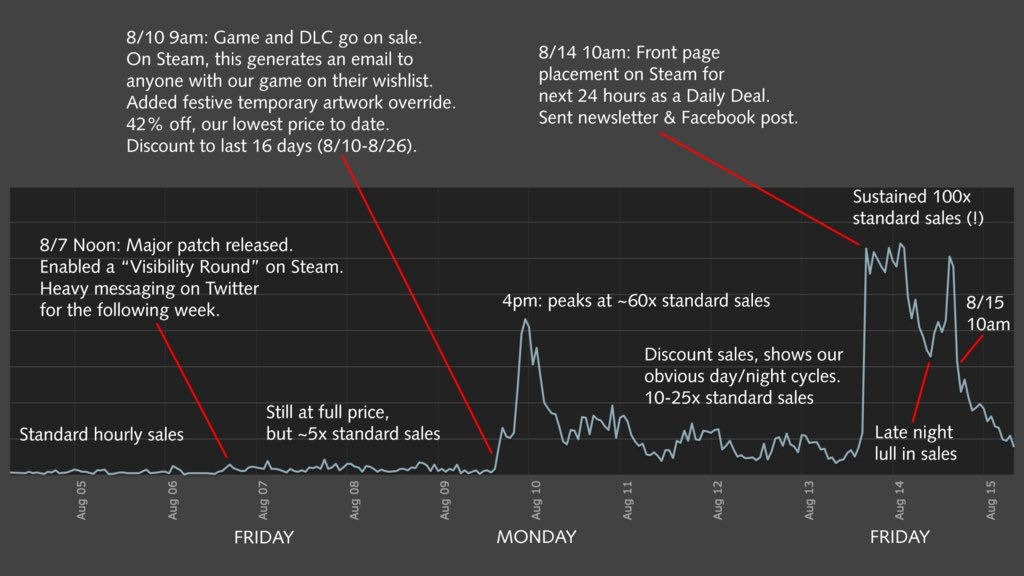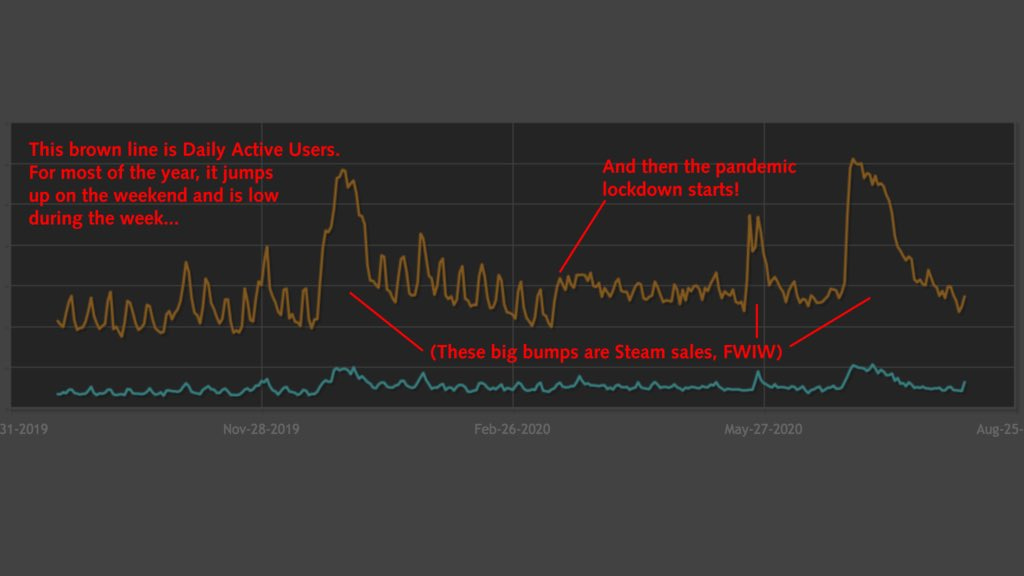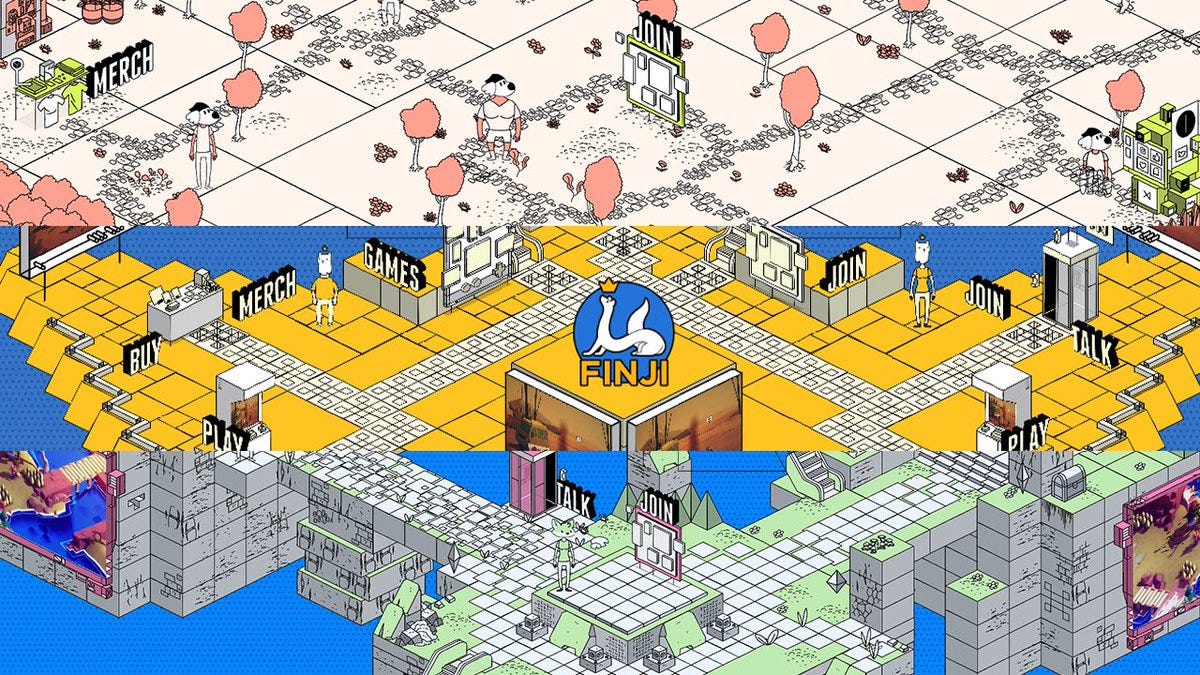Do you want 100x your regular hourly game sales?
Here's how West Of Loathing did it.
[Hi, I’m ‘how people find your game’ expert Simon Carless, and you’re reading the Game Discoverability Now! newsletter, a regular look at how people discover and buy video games in the 2020s.]
Welcome to the GameDiscoverabilityland weekly round-up, where-in I try to pack a whole bunch of game platform/discoverability things into a single post - without going hopelessly over my word limit.
Plenty to get through this week, and miraculously only one extra news item about the ubiquitous Fall Guys (!) So let’s get started…
West Of Loathing’s 100x revenue boost

Over on Twitter, Kevin Simmons from West Of Loathing devs Asymmetric was kind enough to share the results from a current Steam sale of their well-performing (and excellent!) comedy stick figure RPG.
As he notes, “[On the] three year / 1111 day anniversary sale on Steam we used every tool we had to build awareness. The Steam front page is such a massive driver of sales! 100x! In the end, we’ve made about 5x a normal month’s income over these 16 days.”
Summing up, that’s a) a Visibility Round, which Steam gives you to bump your game’s visibility a little on Steam when you want; b) a record ‘% off’ sale, which sends an email to hundreds of thousands of West Of Loathing’s Steam wishlisters; c) a Steam Daily Deal on top of that, with additional email/social media outreach.
In the Twitter replies, somebody asked Kevin how the Daily Deal was secured, and he noted: "We contacted [Steam] about 6 weeks prior and explained what we were planning for our event and asked if there were any DD openings. They contacted us once early on about a DD, but it was at a point where we didn’t want to discount the game by 30%, so we passed."
Not all of us have access to all of those things. But it’s important to understand that everyone’s Steam sales graph looks a bit like this in terms of extremes. You’ll see days or weeks of ‘copies sold’ that are chugging along at a low base, whether that be 10 copies a day or 100 copies a day, and then sharp spikes around sales. That’s a super impressive peak, though.
Finally, Kevin also posted a look at Daily Active Users for the past few months that I thought was interesting:

In particular, it shows a COVID-19 pandemic effect, something that I haven’t seen discussed much via Steam graphs. (When nobody’s going anywhere, of course weekends and weeks would blend into a smooshy DAU mess.)
Is digitizing the game event the way forward?

Obviously, having been involved in GDC for the past 15+ years, the COVID-19 crisis has given me an opportunity to reflect on what the ‘not actually meeting in person’ version of an online event should look like.
By far the most innovative approach I’ve seen is Indie Arena Booth Online, the virtual version of the Gamescom area. This starts on Thursday, August 27th and runs through August 30th as an in-browser experience where you can actually ‘walk’ through dev-designed booths. Here’s the trailer:
The example booths for different games shown at the top of this section are from Finji, which has announced virtual booths, playable demos, a virtual merch store and streaming video appearances based around the event.
I haven’t had a chance to try it yet (I’m writing this on the 26th), but I’d be curious to hear what readers think. Does it provide the unique experience - and reach - that make a difference to games and players? (The tech is certainly neat.)
We’re all experimenting here. So whether it be small and perfectly formed like the Wholesome Snack indie game micro-showcase (6k YouTube views) or large and sales-affecting like the new Nintendo Indie World showcase (770k YouTube views, and multiple eShop-charting titles afterwards), it’s hearts and minds that need influencing.
And I think we’re always open to new ways to do that, if some of the old physical ones aren’t practical or safe right now - whether this is a Napster moment for events or not.
Other goodness…
You know what, there’s a lot of other things going on in game discovery and platform/biz land right now. So let’s whistle through those, too:
More transparency from Ryan Sumo (who gave us Academia: School Simulator numbers), since he’s posted in detail about pre-launch hype and wishlists (28k so far) for ‘evil overlord simulator’ Ruinarch. Amazing transparency and data in here. It looks like an attractive subgenre + some medium-sized YouTubers streaming pre-release is going to make it a decent launch for the game’s size/budget. (He’s going to tell us real launch numbers soon!)
Future Friends’ Thomas Reisenegger has a Twitter thread with links to his favorite GDC 2020 Summer talk videos, including lectures from Victoria Tran and Davionne Gooden, lots more of which are now up for free on GDC Vault (non-starred links), for those who didn’t spot it.
A follow-up about Valve/Steam and its China plans - Nick Johnson from Win.gg told me that: “Currently, Chinese CSGO & Dota 2 users have the choice between a locked-down version of Steam that [Perfect World] calls the "International Server" and PW's "National Server." Players are incentivised… to move to the National Server through improved servers… in-game items and cosmetics.” Not sure what this portends for third parties using Steam, but I guess this means the Perfect World deal is more about Valve’s own games so far?
Continuing his ‘fire, ready, aim’ approach (lol), my No More Robots colleague Mike Rose sparked headlines by pointing out how tricky Descenders was to find via name search on PlayStation 4 immediately after launch. (I checked on PSN and it’s now resolved. But it looks like a longstanding issue with how search caches/prioritizes at launch - GameSpot commenters note it’s happened with multiple other games.) Smaller details like this do matter to devs. But in addition, all stores need to focus on the broad discovery strokes.
I’m a believer that pricing is both a) vital and b) negotiable, so was interested to see this New York Times piece on music: ‘How Much Is an Album Worth in 2020: $3.49? $77? $1,000? Maybe $0’. Some of this is the physical premium: ‘[Nipsey] Hussle understood that the physical album was no longer a music delivery system, but a proxy for fan enthusiasm, a merch totem of its own.’ But there’s wider questions about digital pricing - bravo to Spiritfarer for launching at $29.99 recently, for example.
Interested to hear Dan Marshall’s views on how pushing people for positive Steam reviews helps your game sell. I don’t completely agree - more positive reviews aren’t a major sales driver on their own. But push messaging your game is out and is good (soliciting reviews!) probably does. You should all be less shy - especially since people read fractions of their social media feed nowadays.
A galaxy-brain take on the Apple vs Epic thing (specifically platforms as walled gardens in general) comes from tech analyst Benedict Evans, and I thought this was interesting: “Epic's proposal is full of holes, and Epic’s problem is really pretty peripheral, but I’m much more interested in Spotify and Stadia, where the situation now looks unsustainable, and that’s where we’re more likely to see changes.”
Microlinks round-up: an opinion piece on Xbox Game Pass (& Battletoads) which notes: “When a game is available through a subscription service and you’re not paying for it directly, it changes how you evaluate it.”; an interview with IGN’s Tina Amini discussing how large media outlets evaluate pitches; a good round-up thread on Unity’s prospectus for its IPO, if you’re curious about revenue/focus; and look, don’t put logos at the front of your game trailer.
Finally, million-sub YouTuber Austin McConnell has created a handy video about Fall Guys which echoes a lot of my comments about how the darn thing got so popular, and adds others:
And that’s it for this week! Check back in early next week, for another focused article on *consults notes* how Frasier’s apartment would make a great survival horror game level.
Take care,
Simon.
